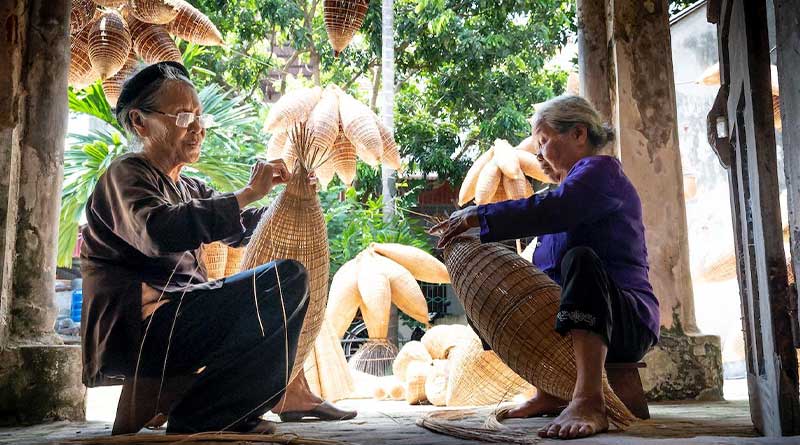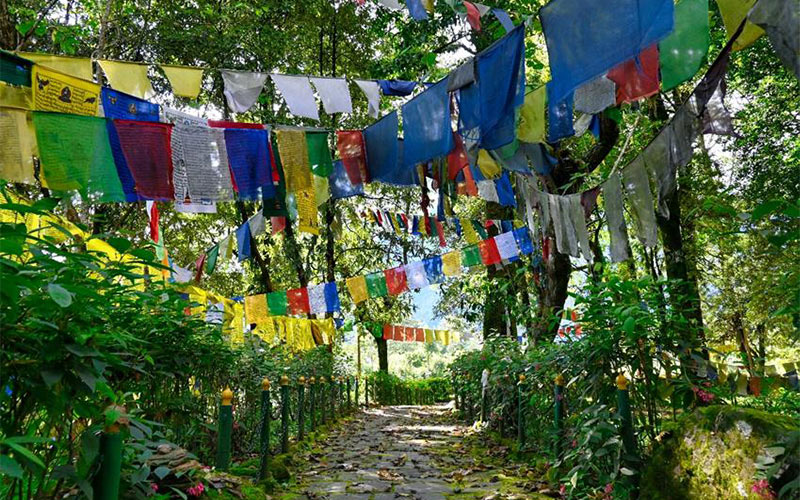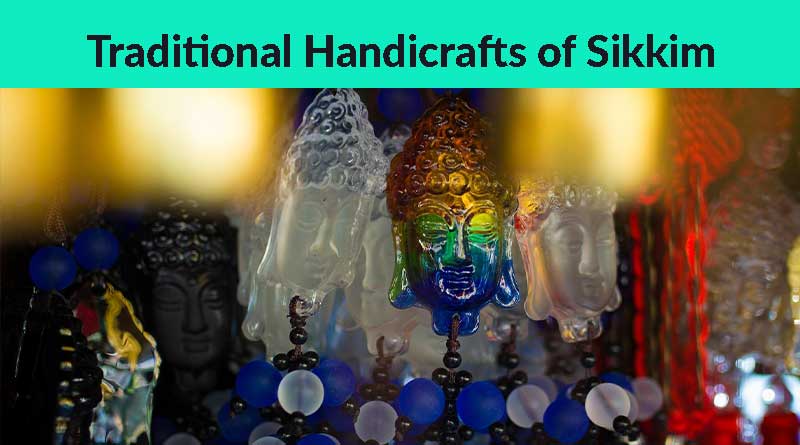7 Beautiful Traditional Handicrafts of Sikkim
Living in northeastern India is a true treasure called Sikkim. This small state is home to breathtaking landscapes, green valleys, high mountains, forests, lakes, endangered species, and much more.
Sikkim is also the least populated state in India, so the calmness and tranquility of the place inspired creativity and spirituality among everyone living there. The art in Sikkim is like nowhere else, and this shows in their stunning handicrafts.
The beauty of these handicrafts is as elegant as the surrounding nature. They are highly detailed, colorful, and durable, and they show the amazing skills of the craftsmen who made them. So, read on to learn more about the handicrafts of Sikkim!
A Little About Sikkim
Sikkim is a state in northeastern India known for its biodiversity, breathtaking nature, and rich heritage. Although it is the second smallest state in India, its economy depends mainly on tourism.
The people of Sikkim are known for their love of art. As you explore Sikkim, you will see artisan traditions that have been passed down from one generation to the next. The beauty of nature and the amazing crafting skills are visible in the handicrafts and handlooms all around the state.
In fact, the government is working constantly to keep the arts and handicrafts alive. They have founded the “Handicraft and Handloom Institute” to help promote and preserve this kind of art.
Handicrafts of Sikkim
The people of Sikkim have used all kinds of items to show their craft and eye-catching art. For instance, they have used wood, bamboo, cane, cotton, silk, wool, dyes, and more. Here are some of the traditional handicrafts in Sikkim:
1. Woodwork
The woodwork of Sikkim is one of the first things you will notice when you visit the state. The exteriors of monasteries and buildings are decorated with fascinating woodwork.
You will also notice low wooden tables called “choktse” everywhere you go. They are beautifully painted with ornamental motifs and carefully finished. Moreover, they are foldable and very convenient. You can also find them in many different patterns.
Wooden masks are also popular among the tourists and visitors of Sikkim.
2. Thangkas
A thangka is a traditional Tibetan Buddhist painting that is unique to Sikkim. Since many people in Sikkim follow Tibetan Buddhism, these painting scrolls hold a lot of value and importance among the community.
Thangkas show an image of a deity like Buddha or Tara. They can also show other important figures or spiritual symbols. They are mainly used for religious purposes, like meditation and praying.
Due to their religious importance, artists produce these paintings with utmost care. They are painted on cotton or silk with natural dyes and even gold with high attention to the smallest details. Since they are sacred objects, you can usually find them at monasteries and temples.
After the thangka is complete, a special ceremony is made for it by a Buddhist priest to infuse it with blessings.
Nowadays, thangkas are commercialized to help Buddhist monasteries and temples earn a living.
3. Bamboo and Cane Crafts
Bamboo and cane are eco-friendly and extremely durable, so they’re popular among the people of Sikkim. Moreover, bamboo is the fastest-growing plant on earth and Sikkim is blessed to have many species of it.
Due to the many benefits of bamboo, it has become a good substitute for agricultural tools, furniture construction, and housing in Sikkim.
Local artisans and craftsmen use bamboo and cane to make furniture, mats, baskets, decorative flowers, dustbins, picture frames, pen stands, and more. Due to these many uses, they’ve become an integral part of the lives of the Sikkimese people.
Bamboo and cane are also used to make products that are popular among tourists such as flower vases, hair clips, beer mugs, and fruit baskets. That’s why they are an important part of the economy of Sikkim.

4. Handlooms
Knitting and weaving are age-old traditions in Sikkim. Generation after generation is brought up to learn this skill and earn their living by creating these fascinating pieces of art. These products are crafted with colorful and traditional designs, which makes them unique and very popular.
In fact, woven textiles are some of the most commonly bought handicrafts in Sikkim, especially thara, which is a textile woven by Lepcha weavers.
Some of the woven products they make in Sikkim are shawls, jackets, blankets, bags, etc. They also make garments, dolls, batiks, and leatherwork. All of these products are made from cotton, silk, wool, and other natural fibers.
The people of Sikkim are hard believers in recycling. They very elegantly recycle old woolen products into new ones, which helps them save money and follow new fashion trends.
5. Metal work
Metalwork is also an essential handicraft in Sikkim. Sikkimese people use brassware and copper to create stunning decorations and for practical work as well.
They use metals to make different designs on lamps, daily utensils, decorations, etc. Apart from this, they make Buddhist figurines using copper. You can see the facial expression and all the features of these figurines carved very skillfully.
What makes these figurines different from the other ones made in India is that they have Mongolian features.
The way they do these metal-casted figurines is that they carve them on wax and take an impression of them. Then, they pour liquid copper into the impression to create, which solidifies and creates the figurines.
The last step is finishing and polishing the figurine and painting it with different colors.
6. Carpets
Weaving carpets is another old tradition in Sikkim. In fact, the women of Sikkim are some of the oldest weavers in the world and they are experts at making carpets.
The carpets usually have stylish patterns like dragons, floral motifs, Buddhist figurines, geometrical patterns, objects from nature, etc.
The carpets in Sikkim are made of wool, that’s why they’re known for their high durability. They’re also dyed with local vegetable dyes made in Sikkim itself. A lot of hard work goes into making these carpets, especially since they are hand-woven on a frame loom.
7. Carving
The people of Sikkim are masters of carving. Whether on wood or wax, they can carve the most beautiful and challenging designs. The types of wood they carve on are usually walnut, maple, and pine.
One of the most popular carving styles they use is “Namthang.” It involves carving floral designs on wooden panels. You can see the excellence of the craft at the monasteries which are decorated with this type of art. The craftsmen also usually carve Buddhist icons and symbols.
Importance of Sikkim’s Handicrafts
The handicrafts of Sikkim hold a lot of significance for the people living there and the state as a whole. Here are some examples:
1. Source of Income
Making handicrafts is a craft that has been passed down through generations in Sikkim. So, it is a fundamental part of the economy of this state and a source of income for the people living there.
The locals train for years to learn the craft and gain the skills. Later on, they can sell these crafts to tourists or put them on sale in the local markets. Monasteries and temples also sell these handicrafts as souvenirs for visitors to earn a living.
2. Religious value
The handicrafts in Sikkim hold a lot of religious value. In fact, some of them are even sacred like thangkas and prayer flags. These handicrafts are deeply rooted in Buddhism, which is the dominating religion in the state.
Artisans show their gods, goddesses, and other religious icons in paintings. They use them for praying and decorating the monasteries and temples all around Sikkim. The people there see them as a way for divine blessings and spiritual connection.
Buddha and other religious icons are also carved into statues and metal-casted figurines. You can see them in people’s homes and monasteries. All of these handicrafts are believed to bring good fortune, peace, and harmony to the people and that’s why they hold a lot of religious significance.

3. Preserving the Heritage
Handicrafts are also a way to preserve the rich cultural heritage of Sikkim. They are used to show icons, designs, and ad motifs that have been passed down through generations.
The young people of Sikkim are trained for years to preserve this traditional craftsmanship. Training is provided at workshops and schools all over the state to provide the young with the proper skills they need to preserve this art.
Local markets and fairs also help spread awareness among visitors and tourists about the art and cultural heritage of Sikkim by displaying handicrafts.
4. Showcasing the Skills
The skills of the craftsmen of Sikkim are extraordinary – they are true masters of the craft. They did not only pass down the skills from one generation to the next but also improve upon them.
Over the centuries, they have refined their craft and used different methods to weave, carve, and create very delicate artwork. You can see the amount of detail in their handicrafts and how dedicated they were to making them.
5. Promoting Tourism
Handicrafts also play a vital role in promoting tourism in the state of Sikkim. These unique and stunning pieces of art attract tourists who are interested in Buddhism and the culture of Sikkim from everywhere. They can watch the fascinating process of making these handicrafts and buying them as souvenirs as well.
Tourism, in return, helps promote the culture of Sikkim and helps artisans earn a living.
Government Initiatives
The government of Sikkim understands the significance of handicrafts and their vital role in the economy of the state. That’s why they took some initiatives to help the artisans and preserve the tradition.
1. Government Institute of Cottage Industry
The Government Institute of Cottage Industry was founded in 1957 to preserve and develop the art and handicrafts of Sikkim. They have a section at the institute for selling different kinds of handicrafts such as wooden masks, tables, carpets, traditional bags, etc.
The items they sell are very popular among tourists and they showcase the culture and rich heritage of Sikkim. It is only 1 km away from the main Gangtok market.
2. Directorate of Handicrafts and Handloom (DHH)
The Directorate of Handicrafts and Handloom first started as a training center for locals to learn the traditional arts and crafts of Sikkim. Now, it has become a major reservoir of stunning handicrafts and handlooms. Inside, you will find thangkas, furniture, carpets, canvas wall hangings, and much more.
The directorate is still a major center for training. In fact, it has 32 branch training centers all around Sikkim with a total capacity of 388 trainees. The trainees learn all the skills they need to create impressive handicrafts that meet the high standards of Sikkim.
Another main objective of the DHH is to promote an environment-friendly working culture. They also aim to set very high standards for all the handicrafts in Sikkim.
They not only showcase and promote the main handicrafts like thangkas and carpets but also the ones that are not so popular like the traditional art of Lepcha Hat.
The main age group of trainees that they target is between 14 to 24 years old. Those trainees get the opportunity to be self-employed and earn a living while working from home.
Where to Buy Handicrafts in Sikkim
It is not hard to find handicrafts in Sikkim as you will find them all around the state. However, some places are popular among visitors.
- MG Road is one of the main commercial areas of Gangtok. There, you will find all kinds of handicrafts but make sure they’re authentic.
- Old Market is a bustling market in MG Marg with a lot of Dogra jewelry and handicrafts. However, make sure you bargain for the best price you can get.
- Buddha Park has a lot of shops where you can find stunning pieces of handicrafts to bring back home.
- The Directorate of Handicrafts and Handloom (DHH) is a reservoir for any kind of handicraft that you want. All the items are high-quality and crafted according to the high standards that they set.
Final Thoughts
The handicrafts of Sikkim are pieces of art that hold immense significance. They not only preserve the heritage of the past but also help the locals earn a living and enhance the economy of the whole state. We hope this article has provided you with all the information you need about the handicrafts of Sikkim!



